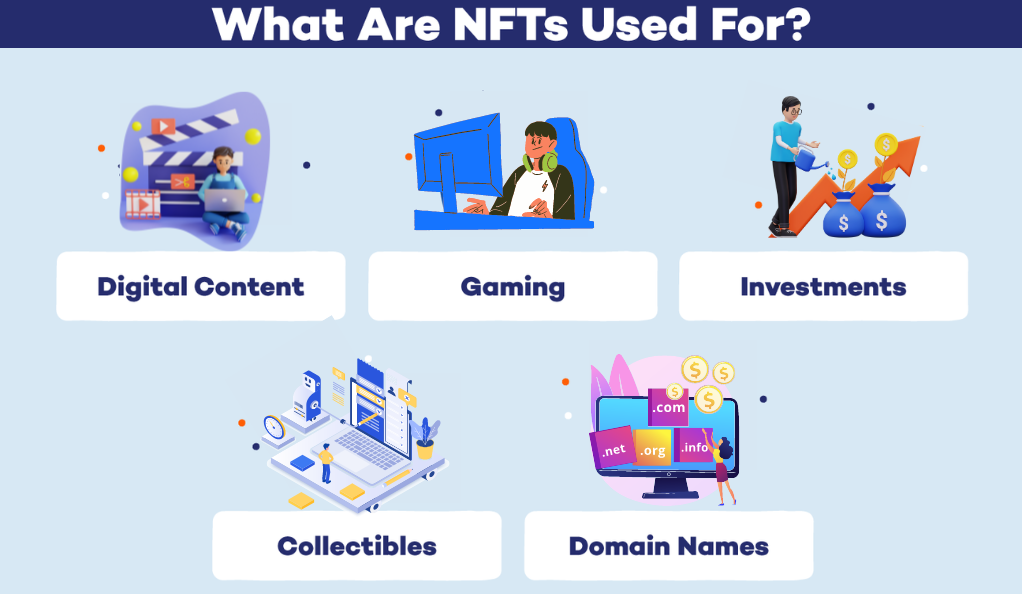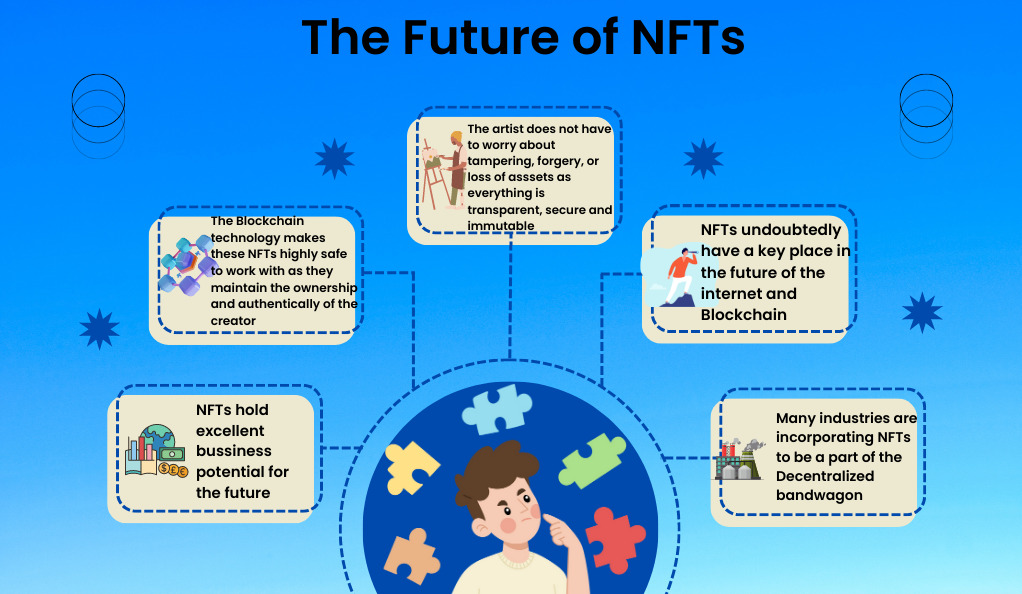As we venture deeper into the digital age, one emerging technology has captured the collective imagination like no other: non-fungible tokens, or NFTs. These digital assets are shaping up to be the new frontier in the digital world, driving innovation in sectors ranging from art to finance. But what does the future hold for this disruptive technology? Let’s delve into the fascinating world of NFTs and see where it might be heading.
Understanding NFTs: A Quick Recap
Before we jump into the future of NFTs, let’s take a step back and clarify what they are and what they have achieved so far. This understanding will offer us the necessary context to make sense of the predictions we’ll later delve into.
What are NFTs?
NFTs are unique digital assets secured on a blockchain, the same decentralized ledger technology that powers cryptocurrencies like Bitcoin and Ethereum. The word ‘non-fungible’ means that each token is unique and cannot be replaced with another, much like an original painting or a signed copy of a book. This differentiates them from cryptocurrencies, which are fungible and can be exchanged on a one-for-one basis.
NFTs have attracted considerable attention due to their ability to authenticate digital assets, thereby creating a digital scarcity. This feature has been instrumental in offering new revenue streams for artists, musicians, and other creative professionals, who can now sell their works directly to their audience without the need for an intermediary.
The Impact of NFTs So Far
NFTs have primarily made waves in the art world, allowing digital artists to monetize their work in ways never before possible. Memes, GIFs, tweets, and digital art pieces have sold for astronomical prices, causing both excitement and skepticism. But NFTs are not just about art. They’ve also found applications in domains as varied as real estate, intellectual property, and gaming, providing these sectors with new tools to manage ownership, licensing, and transfer of digital assets.
As such, NFTs are redefining the concept of value in the digital world, making way for a new digital economy that is marked by decentralization, transparency, and inclusivity. Despite this potential, NFTs have also been criticized for their environmental impact and speculative nature, raising questions about their sustainability and long-term value.
Future Predictions for NFTs
The current application of NFTs is just the tip of the iceberg. The potential uses and implications of NFTs are far-reaching and diverse. As the technology continues to evolve and become more sophisticated, we can expect to see some significant changes on the horizon.
Expanding Marketplaces
The boom in NFTs is likely to give rise to more diverse and specialized marketplaces. These platforms will cater to various niches, from digital art and music to virtual real estate and gaming. As these marketplaces grow, we can expect them to refine their offerings and user experience, fostering more robust and vibrant communities around NFT trading.
Additionally, as these NFT marketplaces mature, they could also offer advanced features and services, such as fractional ownership, which would allow multiple users to share ownership of a single NFT. This could make NFTs more accessible and further drive their adoption.
Rise of NFTs in Gaming
NFTs are set to revolutionize the gaming industry by adding a new layer of interaction and monetization. In the world of gaming, NFTs can be used to represent in-game assets, which players can own, trade, or sell. These could range from skins and weapons to virtual land and characters.
This gives rise to what is known as ‘play-to-earn’ models, where players can earn real-world value from their in-game achievements. By blurring the line between the virtual and the real economy, NFTs could offer a new form of digital empowerment, where gamers can reap tangible rewards from their passion and skill.
NFTs in Real Estate
The real estate sector is primed for disruption with NFTs. The tokens have the potential to digitize real estate assets, making buying, selling, and transferring property as easy as sending an email. Each property can be tokenized as a unique NFT, which would represent a verifiable claim of ownership that can be traded transparently and efficiently on the blockchain.
Moreover, NFTs could also enable novel real estate models, such as fractional ownership, where a property is divided into numerous tokens that can be bought and sold independently. This could democratize access to real estate investment, allowing anyone to buy a ‘piece’ of a property, irrespective of their financial status.
Decentralized Finance (DeFi) and NFTs
Decentralized Finance (DeFi) is another domain where NFTs could have a significant impact. By tokenizing unique assets as NFTs, these assets can be incorporated into the DeFi ecosystem. For instance, NFTs could be used as collateral for decentralized loans, or they could be bundled into unique financial products, thereby expanding the possibilities within the DeFi space.
The convergence of NFTs and DeFi would not only extend the utility of NFTs but also introduce more liquidity and versatility into the DeFi market. This synergy could also spur further innovation in the crypto space, creating a more inclusive and diverse financial ecosystem.
NFTs and Intellectual Property
NFTs could serve as a powerful tool for managing and trading intellectual property rights. By tokenizing intellectual property as NFTs, creators could maintain control over their work, track its use, and receive compensation for their work more easily and transparently.
For instance, a musician could tokenize their song as an NFT and set up smart contracts that automatically pay them royalties every time their song is streamed or downloaded. This could disrupt traditional copyright and royalty systems, offering a more creator-friendly alternative.
Challenges Ahead
As with any nascent technology, NFTs face challenges that need to be addressed as they move into the mainstream. From environmental concerns to legal ambiguities and market volatility, the road ahead for NFTs is not without obstacles.
Sustainability Concerns
One of the main criticisms leveled against NFTs pertains to their environmental impact. The creation and transaction of NFTs currently rely on energy-intensive processes, contributing to carbon emissions. This has sparked a debate within the NFT community about how to make the technology more sustainable.
Some possible solutions could include transitioning to more energy-efficient blockchain protocols, implementing carbon offsetting practices, or developing new standards for ‘green NFTs.’ Addressing this issue is crucial for the long-term viability of NFTs and their broader acceptance.
Legal Implications
As NFTs challenge traditional notions of ownership and property rights, they also present new legal complexities. How do we determine the rights of an NFT owner? Can an NFT confer copyright or just ownership? What happens in cases of NFT theft or fraud?
These are just a few of the questions that regulators and legal experts will need to tackle as the NFT space evolves. The lack of clear regulations and legal precedents makes this a tricky but crucial area that will undoubtedly shape the future of NFTs.
Market Volatility
Finally, the NFT market is highly volatile, with prices subject to wild swings and speculative bubbles. While this volatility can offer high returns for some, it also makes the market risky and unpredictable, deterring more cautious investors and users.
As the NFT market matures, it will need to find ways to mitigate these risks and ensure more stability. This could involve the introduction of insurance products, hedging mechanisms, or more transparent pricing models, all of which would contribute to a more robust and trustworthy NFT ecosystem.
Conclusion: The Next Digital Frontier
The future of NFTs is undoubtedly promising, with endless possibilities across various sectors. However, like all disruptive technologies, NFTs also present challenges that we need to address. If we can navigate these obstacles, NFTs have the potential to redefine our relationship with the digital world, opening up new avenues for innovation, interaction, and value creation.
In this journey, every individual, artist, gamer, investor, and technophile has a role to play. As we continue to shape this nascent technology, it’s important to keep an open mind, stay informed, and contribute to a future where technology serves as a tool for empowerment and creativity.
FAQs
1. What are NFTs?
NFTs, or non-fungible tokens, are unique digital assets that are stored on a blockchain. They can represent a variety of digital and physical items, from digital art to real estate.
2. What industries can benefit from NFTs?
NFTs can impact a wide range of industries, including art, music, gaming, real estate, and finance. They can enable new business models, such as ‘play-to-earn’ in gaming or fractional ownership in real estate.
3. What challenges does the future of NFTs face?
NFTs face several challenges, including environmental concerns due to their energy-intensive processes, legal ambiguities around ownership and rights, and market volatility.
4. How can NFTs impact the gaming industry?
NFTs can transform the gaming industry by allowing players to own, trade, or sell in-game assets as NFTs. This could give rise to ‘play-to-earn’ models, where players can earn real-world value from their in-game achievements.
5. Are NFTs sustainable?
The current process for creating and transacting NFTs is energy-intensive, raising sustainability concerns. However, solutions like transitioning to energy-efficient blockchain protocols or creating ‘green NFTs’ are being explored to address this issue.


